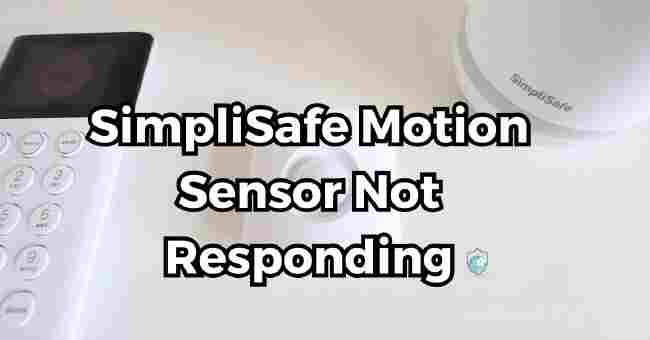Table of Contents
Why is my SimpliSafe motion sensor not responding? I’ve been there too. Last year, I felt a rising panic when my SimpliSafe app didn’t send its usual overnight alerts.
Rushing to inspect the devices first thing in the morning, my heart sank realizing the motion sensor was unresponsive.
However, using SimpliSafe’s online tips, I systematically troubleshot issues like low battery, improper positioning near thick walls, and external wireless interference from a new baby monitor.
Within an hour, I got the sensor functioning properly again with strategic relocation – no costly replacement parts required.
In this in-depth troubleshooting guide, I’ll walk you step-by-step through understanding common reasons your SimpliSafe motion sensor may have stopped working, figuring out the likely cause, and resolving the problem so you can get your home security back up and running.
First Things First: What Signs Indicate My SimpliSafe Motion Sensor Not Responding?
Before diving into fixes, let’s cover the main signs that indicate your SimpliSafe motion sensor is having issues:
- You’re not getting notifications when there’s motion, like usual
- Your SimpliSafe base station doesn’t make alarm sounds when it should
- You see error messages like “Sensor Offline” or “Communication Error”
- The motion sensor’s light is flashing red or blue (Gen 1 sensors)
- Sensors randomly go offline or messages say it’s “open”
Lack of notifications and alarms are the biggest red flags. But also note down any odd behavior with lights or error messages – these all give clues to potential causes.
An important thing to check is your SimpliSafe app notification settings. If those are disabled for certain sensors, it would explain why you’re not getting alerts.
So triple check your notification settings match what you expect before assuming your sensor is broken.
Okay, notifications enabled…now what?
Reasons Why Your SimpliSafe Motion Sensor May Stop Responding
Many things can potentially interfere with or disable a motion sensor. But don’t worry – most causes of SimpliSafe motion sensor problems are pretty straightforward to resolve once you know where to look.
Here are the most common culprits behind non-responsive SimpliSafe motion sensors:
1. Dying Battery
Like most wireless electronic devices, SimpliSafe motion sensors are battery powered. If the battery runs down, the sensor will become less reliable or stop working altogether.
- Older Gen 1 SimpliSafe sensors in particular are prone to battery issues since they don’t have a low battery indicator.
- Newer Gen 2 models display battery notifications, but will still eventually stop working as power gets critically low.
Low battery is one of the most frequent reasons SimpliSafe motion sensors stop detecting motion.
Regularly replacing batteries per the manufacturer recommendation prevents problems.
2. Mounting Location & Interference
Where you place the motion sensor plays a huge role in whether it reliably detects motion and connects with the SimpliSafe base station.
Common motion sensor mounting problems include:
- Mounted in very sunny rooms. Direct sunlight can overheat and disrupt the sensor.
- Close to walls, appliances or thick furniture that block wireless signal.
- Too high or too low relative to the area it should cover. This leaves “blind spots”.
- Too far away from the SimpliSafe base station for a reliable connection.
Additionally, wireless devices like Wi-Fi routers, baby monitors, Bluetooth speakers, etc. operating on a similar frequency can create interference if placed too close to the sensor.
Carefully choosing placement is crucial so your SimpliSafe motion sensor has an unobstructed view and strong communication signal.
3. Physical Damage or Dislodging
It’s also possible something physically damaged or dislodged your motion sensor. For example:
- Pet/child/cleaning accident knocking the sensor off the wall
- Electrical surge frying the sensor circuits
- Exposed to liquids or debris clogging components
- Attempted tampering by an intruder
In most cases where physical interference occurs, you’ll get an accompanying error about the sensor being offline or tampered with.
So if you see those warnings, thoroughly inspect the device for any signs of damage.
4. Software & Connectivity Issues
Finally, while less common, glitches in the system software or connectivity can also cause problems:
- SimpliSafe sensor/base station firmware bug
- Wi-Fi network interruption impacting connectivity
- Server-side app notification issues
Rebooting and keeping firmware updated often resolves intermittent software issues. Just make sure your Wi-Fi is working too before assuming sensor hardware failure!
Alright, now that you know the main reasons why SimpliSafe motion sensors potentially stop responding, let’s get to troubleshooting.
Step-By-Step Troubleshooting When Your SimpliSafe Motion Sensor Stops Working
When dealing with a non-responsive SimpliSafe motion sensor, stay calm and tackle troubleshooting methodically.
I like to think of it as eliminating suspects to uncover the culprit!
Here is a step-by-step process:
Step 1: Replace Batteries
Since low battery is the most common cause of SimpliSafe motion sensors failing to respond, always start by replacing batteries.
- For Gen 1 models, unscrew the back panel and insert 2 new CR123A batteries, ensuring correct polarity.
- For Gen 2 models, slide the battery tab to unlock the cover and swap in a new CR2450 battery matching polarity.
Battery replacement is quick and rules out the most likely culprit.
Test your sensor after replacing batteries. If the issue persists, move on to other troubleshooting steps.
Step 2: Inspect Sensor Placement
Next, thoroughly check where you mounted the non-responsive motion sensor:
- Is it positioned correctly to monitor the desired area?
- Is anything obstructing the sensor’s field of view?
- Is it exposed to direct sunlight or radiant heat sources that could overheat it?
- Is it mounted near potential sources of wireless interference like Wi-Fi routers and electronics using similar frequencies?
Carefully inspect from all angles to check for any placement issues or obstructions that could be impacting performance.
Additionally, relocate the sensor temporarily to rule out environmental factors. For example, move it to another room away from sunlight/appliances and test if it suddenly starts working properly.
If you identify placement as the issue, permanently move the sensor to a better location.
Step 3: Rule Out Physical Damage
Thoroughly inspect your non-responsive SimpliSafe motion sensor from all angles looking for any signs of physical damage:
- Cracks, dents or holes in the plastic housing
- Detached or damaged sensor circuit boards
- Debris/liquid inside housing blocking motion detection
- Dislodged/severed power cables (hardwired models)
Refer to the SimpliSafe sensor manual diagrams to understand what the device internals should look like when intact.
If physical damage occurred, the sensor will likely need replacement rather than repair.
Step 4: Reboot and Update SimpliSafe System
Intermittent electrical issues and software glitches can sometimes cause SimpliSafe motion sensors and controllers to misbehave:
First, power cycle your SimpliSafe Base Station by unplugging it from power for 30+ seconds and plugging back in.
Next, log into your SimpliSafe mobile app > Settings > System to check for and install any pending software updates. Updates sometimes resolve sensor bugs.
After rebooting and updating, test if the motion sensor reliably responds. Simple reboots/firmware updates can correct many glitches!
Step 5: Contact SimpliSafe Support
If you still have a non-responsive SimpliSafe motion sensor after methodically troubleshooting placement, hardware, and software issues – reach out to SimpliSafe support.
Contact options include:
- 24/7 phone support
- Chat via SimpliSafe mobile app
Make sure to clearly describe troubleshooting steps you already tried. Support can further diagnose the issue and ship replacement parts if needed.
Many users shared positive experiences with friendly support resolving their stubborn sensor problems:
“I struggled to get one problematic sensor working reliably despite troubleshooting everything. SimpliSafe sent me a brand new replacement sensor free of charge!” – Matt, New Jersey
So don’t hesitate to lean on their expertise so you can get back to feeling fully protected by your home security system!
Pro Tips to Prevent SimpliSafe Motion Sensor Issues
While occasional motion sensor hiccups are inevitable, you can take proactive measures to minimize problems:
Conduct regular walk tests: Once per month, intentionally walk in front of each sensor then verify it properly triggers notifications. Catch reliability declines early.
Inspect externally mounted sensors seasonally: Check for damage from weather/debris. Clear any buildup obscuring the sensor.
Replace backup batteries annually: Don’t wait until batteries fully die. Swap in fresh backups once per year.
Prevent pets/kids from disturbing sensors: Mount out of reach of chaos! Alert kids and pets to leave sensors alone.
Choose mounting locations carefully: Optimize viewing angle and wireless signal strength for maximum uptime.
Following these motion sensor care best practices helps avoid the headache of troubleshooting unresponsive sensors down the road!
Now over to you – what issues have you faced with keeping SimpliSafe motion sensors running reliably? Let me know in the comments if you have any other troubleshooting tips!
FAQs
How Do I Change The Battery In My Simplisafe Motion Sensor?
Changing batteries in SimpliSafe motion sensors is thankfully quick and straightforward!
- For Gen 1 models, use a philips-head screwdriver to remove the back plate and access the battery compartment. Remove the existing CR123A batteries and insert new ones, taking care to match the polarity (+/- symbols).
- For Gen 2 and later motion sensors, locate the battery tab on the bottom of the device. Simply slide it sideways to unlock the battery cover, pop out the CR2450 coin cell battery and insert an identical replacement battery.
And that’s it! SimpliSafe designed the battery swap to be tool-free and take under 60 seconds, so you can easily maintain peak performance. Test that motion detection works properly after replacing the battery.
How Do I Fix A Weak Signal On My Simplisafe Motion Sensor?
If your SimpliSafe motion sensor displays a weak signal warning, try these troubleshooting steps:
- Relocate the sensor closer to the SimpliSafe Base Station to improve signal strength. The fewer physical obstructions, the better.
- Determine sources of interference by turning off nearby electronics like WiFi routers, baby monitors, cordless phones etc. Then check if sensor connectivity improves.
- Upgrade WiFi or base station if you have an older system. Newer SimpliSafe equipment includes signal enhancements.
- Adding an extra SimpliSafe signal extender may also help boost connectivity in tricky home layouts.
With a robust signal between devices, you won’t lose alarm notifications when something moves!
Can I Reset My Simplisafe Motion Sensor?
Yes, resetting a SimpliSafe motion sensor can sometimes help resolve flaky operation or connectivity issues. Here is what to do:
- Remove battery from the sensor for 60 seconds.
- Reinsert battery to power cycle and reset the sensor.
- Open SimpliSafe app > System > Sensors > Remove/Replace process to clear out old device mapping.
- Use automatic or manual onboarding in the SimpliSafe app to re-add the sensor so it creates fresh signal mapping data.
- Test motion detection and connectivity functionality. Often a basic reset and mapping refresh gets balky sensors back on track!
Why Is My Simplisafe Entry Sensor Not Responding?
If your SimpliSafe entry sensor fails to trigger when a door/window opens, common causes include:
- Dead battery – replace it if battery alerts show in the SimpliSafe app.
- Physical misalignment – ensure the sensor lines up precisely when closed.
- Mounting failure – insecure mount could shift alignment over time.
- Interference – relocate sensor away from wireless electronics.
- Damaged sensor/magnet – inspect for any cracks or broken components.
Carefully inspect your entry sensor to diagnose and resolve any underlying hardware issues so you can rely on it capturing door/window breaches!
How Do You Fix Motion Sensors Not Working?
When SimpliSafe or other motion sensors stop triggering, methodically work through these troubleshooting steps:
- Replace non-rechargeable batteries. Low power is a common culprit.
- Carefully reposition the sensor to optimize coverage area and remove any obstructions.
- Clean motion sensor lenses with microfiber cloth to remove dust/debris/insects that could block the sensor.
- For battery-powered sensors, insert batteries for 1 minute then remove for a hard reset.
- Check for settings like “sleep mode” that disable motion detection.
- If issues started suddenly, restore previous firmware/settings.
Still not working? It may be time for replacement sensors – but 9 times out of 10, the above fixes balky activation issues!
How Do You Test A Simplisafe Motion Sensor?
SimpliSafe makes testing motion sensor functionality easy:
- Open the SimpliSafe mobile app.
- Navigate to System > Sensors.
- Select your motion sensor from the list.
- Tap “Check-in” next to the sensor entry.
- Trigger motion in front of the sensor within 30 seconds. Walk across its field of view or wave your hand.
- The app will confirm if motion was detected or not.
Alternatively, most SimpliSafe motion sensors have a physical “Test” button on the device itself. Press and hold this button 10+ seconds until the LED light flashes. Break the light beam to confirm motion detection.
Regular self-tests ensure your sensors stay in working order!
Why Do Motion Sensors Fail?
Like any home technology device, motion sensors can eventually malfunction or fail over time. Common reasons include:
- Dust/grime accumulation internally blocking motion detection.
- Extreme weather damage from improper external installation.
- Overheating due to direct sunlight exposure or poorly ventilated enclosures.
- Blunt force damage or loosening of internal components through repeated activation.
- General wear and tear as components degrade over 5-10 years even with light use.
Taking care to install motion sensors properly, avoiding contamination from environmental exposure and general handling wear helps minimize failures.
But periodic replacement every 7-10 years is advised for continued reliability.
How Long Do Simplisafe Entry Sensors Last?
SimpliSafe builds their easy-to-install entry sensors to withstand typical environmental wear and tear.
With proper placement and maintenance, most users enjoy 5-7 years of reliable performance before considering replacement.
To maximize your investment:
- Ensure interior installation areas don’t exceed 120°F temperatures.
- Check adhesives/screws yearly to verify tight mounting.
- Replace CR2 batteries every 1-2 years.
- Keep alignment intact between sensor and magnet components.
- Follow troubleshooting tips if connectivity issues arise.
With reasonable care, SimpliSafe entry sensors deliver peace of mind during their estimated lifespans! Replacement sensors are affordable and easy to pair when eventually needed.
What Causes Simplisafe Sensors To Go Offline?
SimpliSafe system sensors going offline (aka appearing disconnected in the app) typically signals disruption in communication between devices. Potential causes include:
- Depleted batteries – all SimpliSafe sensors are powered by replaceable batteries.
- Physical obstructions like walls/appliances interfering with wireless signals.
- Damaged antenna or circuitry through accidents/tampering.
- Intermittent Wi-Fi outages impacting connectivity.
- Rebooting the SimpliSafe Base Station can also temporarily take sensors offline until re-syncing.
Thoroughly inspect affected sensors for anything blocking signals or depletion that could explain connectivity loss. Reset procedures and wireless improvements in tricky homes restore smooth operation.
Conclusion
In conclusion, unresponsive SimpliSafe motion sensors typically stem from power deficiencies, physical positioning hindering functionality, hardware damage, or intermittent electrical issues.
Methodically inspecting for root causes, toggling power, moving devices to optimize signal transmission, isolating interference sources, replacing parts, and rebooting systems resolves a majority of problems users face.
Don’t hesitate to leverage SimpliSafe’s great customer support for additional troubleshooting guidance when needed either.
Staying proactive with preventative care also minimizes headaches down the road.




